Cite this document
(“Lit review Literature Example | Topics and Well Written Essays - 2000 words”, n.d.)
Retrieved from https://studentshare.org/business/1654853-lit-review
Retrieved from https://studentshare.org/business/1654853-lit-review
(Lit Review Literature Example | Topics and Well Written Essays - 2000 Words)
https://studentshare.org/business/1654853-lit-review.
https://studentshare.org/business/1654853-lit-review.
“Lit Review Literature Example | Topics and Well Written Essays - 2000 Words”, n.d. https://studentshare.org/business/1654853-lit-review.


